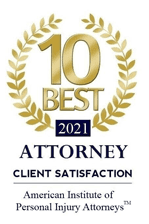Being injured in an accident could result in a serious disruption to your life. Aside from the physical pain and recovery period from your injuries, you may have to miss work for a while until you’re well enough to return. Unfortunately, if you’re like most people, you’re not financially situated to endure a protracted recovery period.
However, you can recover compensation for your injuries. The Baltimore County personal injury lawyers at Parker, Pallett, Slezak & Russell, LLC fight for the rights of accident injury victims. As a personal injury law firm, our attorneys work on a contingency basis, which means you don’t have to pay out of pocket for our professional legal advice. Call today for a free consultation.

Personal Injury Practice Areas
We represent accident victims in the following types of cases.
Car Accidents
Car accidents tend to be one of the most common sources of accidental injuries perennially. There were 28,084 injury crashes and 524 fatal crashes in 2022 in Maryland.
Truck Accidents
Commercial motor vehicles can weigh up to 80,000 lbs and often carry hazardous materials. Because of their massive size, car passengers are usually injured when they’ve been involved in a crash with a semi-truck or large commercial vehicle.
Motorcycle Accidents
Because of their high speeds and minimal frame, motorcyclists are often injured in crashes. The driver may experience two impacts as they almost always have a secondary impact on the roadway.
Premises Liability
The proprietors of premises have a legal responsibility to ensure that they are reasonably safe for visitors. Slips, trips, and falls are among the most common types of premises liability cases, which is why this area of the law is often referred to as “slip and fall.”
Workers’ Compensation
Most Maryland employers are required to carry workers’ compensation insurance. If you are injured at work, regardless of fault, your medical care and a portion of your wages should be covered.
Medical Malpractice
Medical professionals are held to a high standard when it comes to providing patients with appropriate and competent treatment. When they fail in this duty, they may be liable for their patients’ damages.
Product Liability
Consumers have the right to expect the products they purchase to be safe when used as directed. When a consumer is injured due to a design defect, a manufacturing defect, or misinformation about the product, they should be compensated.
Contact a personal injury lawyer in Baltimore County to discuss your accidental injuries in a free consultation session.
Proving a Liability Case in Maryland
In order to prove that your accidental injuries were due to another’s negligence, the following four elements must be present.
1. The Defendant had a Duty of Care
Under Maryland personal injury law, the plaintiff’s attorney must be able to show that the party responsible for the accident had a duty of care to the victim or victims. For example, every driver on the road has a duty to operate their vehicle safely and in accordance with the applicable traffic laws.
2. The Defendant Breached Their Duty of Care
In order to prove their case, personal injury lawyers must demonstrate that the defendant somehow violated their duty of care. For example, in a medical malpractice case, a doctor may have successfully performed surgery on a patient but left a surgical tool inside before closing them up.
3. The Defendant’s Breach of Duty Caused the Accident
Because Maryland follows the contributory negligence principle, personal injury attorneys must only prove that the defendant’s breach of duty was partially responsible for the accident. The plaintiff can recover damages proportionately to that negligence. An example of causation is the owner of a pizza shop failing to clean up an olive oil spill on a tile floor, which is a breach of their duty of care. If the plaintiff slipped in that oil, an attorney can prove that it caused the accident.
4. The Accident Caused Damages
In order for a plaintiff to receive compensation, they must be able to list the monetary and intangible damages they sustained. All accidental injuries involve some level of damages, and an experienced Baltimore County personal injury lawyer tally them.
Damages in a Maryland Personal Injury Case
The state of Maryland categorizes damages in three ways:
Economic Damages
Any item that results in a financial cost to the plaintiff is considered part of economic damages. For instance, all of your medical expenses, lost income from missing work, property damage, etc., are considered economic damages. There is no cap on economic damages in Maryland.
Non-economic Damages
Also referred to as pain and suffering, non-economic damages are meant to compensate the plaintiff for intangible costs, like physical pain, emotional anguish, loss of capacity, etc. While these factors may not result in monetary expenses, they do have a direct impact on the plaintiff’s life. Maryland does cap monetary damages. The current caps are $905,000 for injury cases and $2,262,500 for wrongful death claims with two or more survivors.

Punitive Damages
Punitive damages are intended to punish the defendant for egregious or intentional behavior. While not all cases involve punitive damages, there are no punitive damage caps in Maryland.
A Baltimore County personal injury lawyer can review your claim and tabulate the total damages that you require for full compensation.
Baltimore County Accident Attorney
If you’ve been injured in an accident in Baltimore County, you are entitled to compensation for your physical injuries, pain and suffering, lost wages, etc. If you’ve lost a loved one in a wrongful death accident, you should be able to collect damages for the direct economic costs as well as the pain of losing that family member.
As a personal injury law firm in Baltimore County, we help accident victims get justice. We work on a contingency basis, which means that we only collect our fees if we settle your case or win through litigation. Call today for a free, no-obligation consultation.







